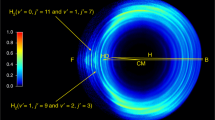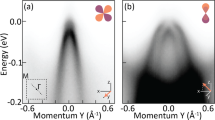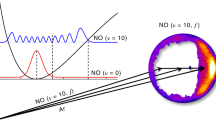Abstract
The transition state, which gates and modulates reactive flux, serves as the central concept in our understanding of activated reactions. The barrier height of the transition state can be estimated from the activation energy taken from thermal kinetics data or from the energetic threshold in the measured excitation function (the dependence of reaction cross-sections on initial collision energies). However, another critical and equally important property, the angle-dependent barrier to reaction, has not yet been amenable to experimental determination until now. Here, using the benchmark reaction of Cl + CHD3(v1 = 1) as an example, we show how to map this anisotropic property of the transition state as a function of collision energy from the preferred reactant bond alignment of the backward-scattered products—the imprints of small impact-parameter collisions. The deduced bend potential at the transition state agrees with ab initio calculations. We expect that the method should be applicable to many other direct reactions with a collinear barrier.
This is a preview of subscription content, access via your institution
Access options
Access Nature and 54 other Nature Portfolio journals
Get Nature+, our best-value online-access subscription
$29.99 / 30 days
cancel any time
Subscribe to this journal
Receive 12 print issues and online access
$259.00 per year
only $21.58 per issue
Buy this article
- Purchase on Springer Link
- Instant access to full article PDF
Prices may be subject to local taxes which are calculated during checkout





Similar content being viewed by others
References
Houston, P. L. Chemical Kinetics and Reaction Dynamics (MaGraw-Hill Higher Education, 2001).
Levine, R. D. Molecular Reaction Dynamics (Cambridge Univ. Press, 2005).
Guo, H. & Liu, K. Control of chemical reactivity by transition-state and beyond. Chem. Sci. 7, 3992–4003 (2016).
Polanyi, J. C. Some concepts in reaction dynamics. Science 236, 680–690 (1987).
Crim, F. F. Vibrational state control of bimolecular reactions: discovering and directing chemistry. Acc. Chem. Res. 32, 877–884 (1999).
Zare, R. N. Laser control of chemical reactions. Science 279, 1875–1879 (1998).
Liu, K. Perspective. Vibrational-induced steric effects in bimolecular reactions. J. Chem. Phys. 142, 080901 (2015).
Liu, K. Vibrational control of bimolecular reactions with methane by mode, bond, and stereo selectivity. Annu. Rev. Phys. Chem. 67, 91–111 (2016).
Loesch, H. J. Orientation and alignment in reactive beam collisions: recent progress. Annu. Rev. Phys. Chem. 46, 555–594 (1995).
Neumark, D. M. Spectroscopy of reactive potential energy surface. PhysChemComm. 5, 76–81 (2002).
Zare, R. N. Optical preparation of aligned reagents. Ber. Bunsenges. Phys. Chem. 86, 422–425 (1982).
Friedrich, B. & Herschbach, D. Manipulating molecules via combined static and laser fields. J. Phys. Chem. A 103, 10280–10288 (1999).
Bowman, J. M., Czakó, G. & Fu, B. High-dimensional ab initio potential energy surfaces for reaction dynamics calculations. Phys. Chem. Chem. Phys. 13, 8094–8111 (2011).
Schatz, G. C. Quantum effects in gas phase bimolecular chemical reactions. Annu. Rev. Phys. Chem. 39, 317–340 (1988).
Zhou, J., Zhang, B., Lin, J. J. & Liu, K. Imaging the isotope effects in the ground state reaction of Cl + CH4 and CD4 . Mol. Phys. 103, 1757–1763 (2005).
Zhang, Z., Zhou, Y., Zhang, D. H., Czakó, G. & Bowman, J. M. Theoretical study of the validity of the Polanyi rules for the late barrier Cl + CHD3 reaction. J. Phys. Chem. Lett. 3, 3416–3419 (2012).
Wang, F., Lin, J.-S., Cheng, Y. & Liu, K. Vibrational enhancement factor of the Cl + CHD3(v1 = 1) reaction: rotational probe effects. J. Phys. Chem. Lett. 4, 323–327 (2013).
Yan, S., Wu, Y.-T., Zhang, B., Yue, X.-F. & Liu, K. Do vibrational excitations of CHD3 preferentially promote reactivity toward the chlorine atom? Science 316, 1723–1726 (2007).
Yan, S., Wu, Y.-T. & Liu, K. Tracking the energy flow along the reaction path. Proc. Natl Acad. Sci. USA 105, 12667–12672 (2008).
Zhang, B. & Liu, K. Imaging a reactive resonance in the Cl + CH4 reaction. J. Chem. Phys. 122, 101102 (2005).
Martinez, R., Gonzalez, M., Defazio, P. & Petrongolo, C. Searching for resonances in the reaction Cl + CH4 → HCl + CH3: quantum versus quasiclassical dynamics and comparison with experiments. J. Chem. Phys. 127, 104302 (2007).
Liu, K. Quantum dynamical resonances in chemical reactions: from A + BC to polyatomic systems. Adv. Chem. Phys. 149, 1–46 (2012).
Wang, F., Lin, J.-S. & Liu, K. Steric control of the reaction of CH stretch-excited CHD3 with chlorine atom. Science 331, 900–903 (2011).
Wang, F., Liu, K. & Rakitzis, T. P. Revealing the stereospecific chemistry of the reaction of Cl with aligned CHD3(v1 = 1). Nat. Chem. 4, 636–641 (2012).
Wang, F. & Liu, K. Differential steric effects in Cl reactions with aligned CHD3(v1 = 1) by the R(0) and Q(1) transitions. I Attacking the excited C–H bond. J. Chem. Phys. 145, 144305 (2016).
Wang, F. & Liu, K. Differential steric effects in Cl reactions with aligned CHD3(v1 = 1) by the R(0) and Q(1) transitions. II Abstracting the unexcited D-atoms. J. Chem. Phys. 145, 144306 (2016).
Wang, F. & Liu, K. Steric effects in the Cl + CHD3(v1 = 1) reaction. Chin. J. Chem. Phys. 26, 705–709 (2013).
Liu, R. et al. Rotational mode specificity in the Cl + CHD3 → HCl + CD3 reaction. J. Chem. Phys. 141, 074310 (2014).
Wang, F., Pan, H. & Liu, K. Imaging the effect of reagent rotation on the dynamics of the Cl + CHD3(v1 = 1, |JK〉) reaction. J. Phys. Chem. A 119, 11983–11988 (2015).
Aldegunde, J. et al. How reactants polarization can be used to change and unravel chemical reactivity. J. Phys. Chem. A 109, 6200–6217 (2005).
Wang, F., Lin, J.-S. & Liu, K. How to measure a complete set of polarization-dependent differential cross sections in a scattering experiment with aligned reagents? J. Chem. Phys. 140, 084202 (2014).
Schechter, I. & Levine, R. D. Products’ angular distribution for stereoselective reactions. J. Chem. Soc. Faraday Trans. II 85, 1059–1080 (1989).
Schechter, I., Prisant, M. G. & Levine, R. D. A classical kinematic model for direct reactions of oriented reagents. J. Phys. Chem. 91, 5472–5480 (1987).
Czakó, G. & Bowman, J. M. Accurate ab initio potential energy surface, thermochemistry, and dynamics of of the Cl(2P, 2P3/2) + CH4 → HCl + CH3 and H + CH3Cl reactions. J. Chem. Phys. 136, 044307 (2012).
Zare, R. N. Angular Momentum (Wiley-Interscience, 1988).
Lin, J. J., Zhou, J., Shiu, W. & Liu, K. Application of time-sliced ion velocity imaging to crossed molecular beam experiments. Rev. Sci. Instrum. 74, 2495–2500 (2003).
Czakó, G. & Bowman, J. M. Dynamics of the reaction of methane with chlorine atom on an accurate potential energy surface. Science 334, 343–346 (2011).
Acknowledgements
The authors thank J.-S. Lin and O. Tkac for assisting with some imaging acquisitions. This work was supported by Academia Sinica and the Minister of Science and Technology of Taiwan (MOST-105-2113-M-001-019-MY3). F.W. also acknowledges support from the National Nature Science Foundation of China (grants 21322309 and 21673047) and the Program for Professor of Special Appointment (Eastern Scholar) at Shanghai Institutions of Higher Learning. G.C. thanks the Scientific Research Fund of Hungary (PD-111900) and the Bolyai Research Scholarship for financial support and the National Information Infrastructure Development Institute for computer resources.
Author information
Authors and Affiliations
Contributions
K.L. conceived and designed the experiments. H.P. and F.W. performed the experiments and analysed the data. G.C. performed theoretical calculations. All authors discussed the results and commented on the manuscript. K.L. wrote the paper.
Corresponding authors
Ethics declarations
Competing interests
The authors declare no competing financial interests.
Supplementary information
Supplementary information
Supplementary information (PDF 488 kb)
Rights and permissions
About this article
Cite this article
Pan, H., Wang, F., Czakó, G. et al. Direct mapping of the angle-dependent barrier to reaction for Cl + CHD3 using polarized scattering data. Nature Chem 9, 1175–1180 (2017). https://doi.org/10.1038/nchem.2858
Received:
Accepted:
Published:
Issue Date:
DOI: https://doi.org/10.1038/nchem.2858
This article is cited by
-
Enhancing reactivity of SiO+ ions by controlled excitation to extreme rotational states
Nature Communications (2023)
-
Mapping the emergence of molecular vibrations mediating bond formation
Nature (2020)
-
Cold quantum-controlled rotationally inelastic scattering of HD with H2 and D2 reveals collisional partner reorientation
Nature Chemistry (2018)
-
Quantum-state-controlled channel branching in cold Ne(3P2)+Ar chemi-ionization
Nature Chemistry (2018)



